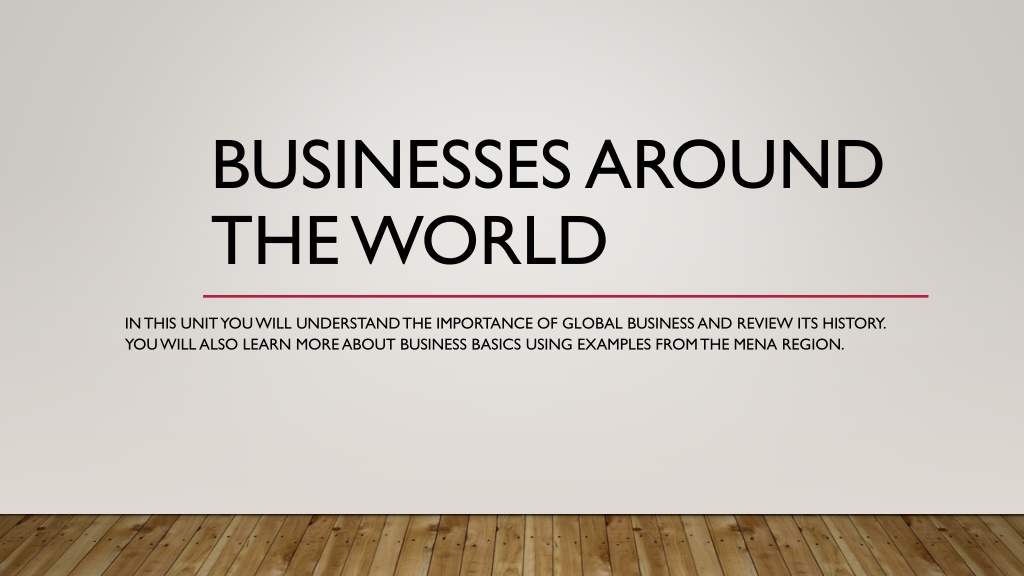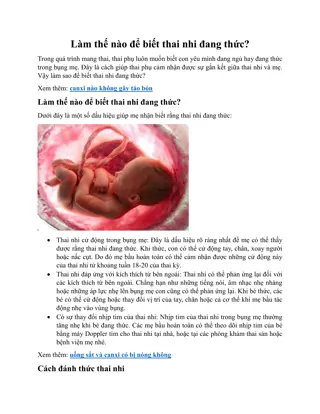The Importance of Global Business and Business Basics
Explore the significance of global business, delve into its history, and discover the fundamental principles of business using examples from the MENA region. Discover why businesses are essential in our daily lives, the difference between needs and wants, the objectives of business, and the historical origins of trade and commerce.
Download Presentation

Please find below an Image/Link to download the presentation.
The content on the website is provided AS IS for your information and personal use only. It may not be sold, licensed, or shared on other websites without obtaining consent from the author. Download presentation by click this link. If you encounter any issues during the download, it is possible that the publisher has removed the file from their server.
E N D
Presentation Transcript
BUSINESSES AROUND THE WORLD IN THIS UNIT YOU WILL UNDERSTAND THE IMPORTANCE OF GLOBAL BUSINESS AND REVIEW ITS HISTORY. YOU WILL ALSO LEARN MORE ABOUT BUSINESS BASICS USING EXAMPLES FROM THE MENA REGION.
LESSON 1: WHY DO WE NEED BUSINESSES? Today life is more complicated than ever before. People are consuming many goods and becoming more dependent on a wide range of products. For example : we depend on cars to travel for even short distances, computers to do our work, and even simpler things like paper for writing, cups for drinking, etc.
HOW DEPENDENT ARE YOU? We as consumers depend on products in our daily lives , some of these products we need and some of them we just want to have : Well ,the things that we usually take for granted like the bed, bed sheets, covers, pillows, pajamas, toothpaste and food are all products that we use and depend on .Even the things we want to have such as :smart phones, tablets, or even X-box. life will not function properly without . If you think for a moment you will decide that life will not be the same without these products.
BUSINESS DICTIONARY Products: are goods or services that businesses produce or provide to satisfy customers needs and wants. Goods: are tangible items that can be physically seen and touched for sale. Services : are intangible activities , work done for someone by someone else ,usually for pay. .Needs: are things essential for living. .Wants: are goods or services which people would like to have, but which are not essential for living.
WHY ARE BUSINESSES IMPORTANT TO THE COMMUNITY? Businesses provide products and services that meet the needs of local communities. creating job growth and providing locals with job opportunities It s a measure of society s progress and prosperity.
OBJECTIVES OF A BUSINESS The main objectives of a business are: Profit making is a main reason why people start a business. Customer satisfaction is an important objective for every business owner. Building a good reputation and gain the trust and loyalty of their customers. (the value of the relationship and the loyalty the business builds with its customers is called customer capital).
LESSON 2 :HISTORY OF BUSINESS THE EARLY BEGINNING People started doing businesses a very long time ago as a very early sign of civilization . They needed very basic things like food, simple tools, and clothing. As a result, they started trading things they had for things they needed. For example :a farmer would trade some of his food for tools or clothes. this worked out fine for people when life was very simple and people needed limited items. As societies progressed, businesses had to become more innovative to cover more items needed and reach more people.
BUSINESS DICTIONARY Barter : exchange (goods or services) for other goods or services without using money. Trade :refers to any activity carried on for the production of income from selling goods or performing services. Operate: is to work, perform, or function.
THE DEVELOPMENT OF BUSINESS THROUGH HISTORY As trade continued to expand into towns , cities with many villages and so on. Businesses became (national / regional / International and global). Businesses types A national business: is one that operates within the borders of a particular country. Like a local business, a national business understands the culture of the country and develops products and services to satisfy its market. Ex: restaurants , grocery stores in Jordan. A regional business : is a type of moderate size business serving the local community and then expand to neighboring countries. Ex: a company that operates and trades in the middle east.
An international business : refers to any business that trades across international borders. it includes the sale(exporting and importing) of goods and services between countries. A global business is a company that operates facilities (such as factories and distribution centers) in many countries around the world. This is different from an international business, which sells products worldwide but has facilities only in its home country.
HOW DO BUSINESSES INFLUENCE CULTURES AND CIVILIZATIONS? Every country specializes in different products due to the fact that their natural resources are different. no one nation can be 100% self-sufficient. That is why nations have to trade among themselves. International business has a great influence on civilizations: It has motivated people to explore more land and places seeking fortunes. It has also improved transportation and many other things. business helped in building of great cultures and improved the living standards of mankind.
GLOBAL BUSINESSES ADVANTAGES Today the world has become one huge global market. Thanks to the Internet, you can purchase anything from any part of the world without leaving the comfort of your home. This development has made a huge change in the world's economy. The flow of goods around the world : Made People able to enjoy a wide range of products from around the world. created more jobs. increased competition. reduced prices. made the world's economy interconnected.
LESSON 3 :NATURE OF A BUSINESS WORLD (CLASSIFICATION OF BUSINESSES BASED ON WHO OWNS AND RUNS THEM AND THE PURPOSE FOR WHICH THEY EXIST ) There are two types of businesses when classified by ownership: 1. Public sector 2. Private sector There are two types of businesses when classified by the purpose for which the business exist: 1. Profit businesses 2. Non-profit businesses
PUBLIC SECTOR Public sector government or state owned and controlled businesses and organizations. The government or the public sector authority , makes decisions about what to produce and how much to charge consumers , such as health and education services . The money for these comes not from users but from the taxpayer.
WHICH BUSINESS ACTIVITIES ARE USUALLY IN THE PUBLIC SECTOR ? In many countries the government controls the following industries or activities Health Education Defense Public transportation Water supply Electric supply
PRIVATE SECTOR Businesses in the Private sector owned and run by individuals or groups of individuals. Which includes both for profit and non-profit businesses. these businesses will make their own decisions about what to produce , how it should be produced and what price should be charged for it . Most businesses in the private sector will aim to make profit.
CLASS ACTIVITY List examples of local businesses(Jordan) in the private and public sector Pubic sector Private sector
TYPES OF BUSINESS ORGANIZATIONS IN THE PRIVATE SECTOR 1) SOLE TRADERS 2) PARTNERSHIPS 3) PRIVATE LIMITED COMPANIES(LTD) 4) PUBLIC LIMITED COMPANIES (PLC) 5) FRANCHISES 6) JOINT VENTURES
SOLE TRADER Sole trader : is a form of business owned and operated by just one person. Sole trader is the most common form of business organization because there are few legal requirements to set it up. Advantages: Owner in complete control. No sharing of profits. few legal regulations must be followed.
PARTNERSHIP When two business people decide to open a business together and agree to share expenses and risks . They are called partners. Partnership: is a form of business in which two or more people agree to jointly own a business. Partnership features: Partnership is a legally binding commitment in the business world. Each partner has ownership in the company, although they may not necessarily share equal ownership. Partners should register their company with proper governmental department in their country (usually ministry of commerce). This way the right of both partners are protected.
Partnership advantages Able to raise capital from partners Responsibilities shared More ideas from new partner(s) Partners motivated to work hard because they would benefit from the profits.
FRANCHISE Franchise :Is when an established business allows another business to use their logo and trade name to produce and market their product or service under certain specifications. Ex: McDonald s / KFC The franchisee buys the license to operate this business from the franchisor . Franchisee Is the business that pays the franchisor to use its name / products, etc. Franchisor Is the existing business the allows a new business to sell its products.
FRANCHISING BENEFITS FOR BOTH PARTIES (FRANCHISEE AND FRANCHISOR) For the franchisee For the franchisor The chances of business failure are much reduced because a well-known products is being sold Rapid expansion occurs for them Advantages The franchisor pays for advertising and train their employees Franchisors get a one-time franchise fee and a royalty (which is a percentage of sales revenue)
PROFIT AND NON-PROFIT BUSINESSES A profit business is an organization that aims at making profits to increase the worth of the business and to provide income for the owners. A Non profit business is a group organized for purposes other than generating profit and in which no part of the organization's income is distributed to its members, directors, or officers. A non- businesses retain only enough money to cover the costs and use the rest of the money to serve the main objectives of the business.
PRODUCTION AND MARKETING BUSINESSES Businesses can also be categorized based on the type of service or product they provide and to whom they provide it: 1. Production of goods (are businesses the produce / manufacture products ,and subcategorized based on who will use the end products) Consumer goods producers (Businesses producing products that will be used directly by consumers - like clothes, food, and personal electronics.) Industrial goods producers (businesses that provide products that serve as raw materials or tools to make consumer goods). electronic parts, farm grown food items (perhaps sold to a grocery store), plastic containers, or machinery - fall into the "industrial goods producers" category.
2. Service providers (are businesses that may be providing their service to individual consumers or may be providing a service needed by an industrial business.) 3. Marketing businesses (they handle the transfer of goods from the producer to the consumer, including transportation, logistics, promotion, and sales to either a middleman in the chain or to The ultimate end consumer).
CHAIN OF PRODUCTION CLASSIFICATION OF BUSINESS ACTIVITIES A production chain can be defined as the steps taken to transform raw materials into ready to use goods by consumers. There are millions of businesses around us. Business activities can be categories in three broad sectors / stages: https://www.youtube.com/watch?v=GuzmULmcU0E The primary sector of industry extracts and uses natural resources of earth to produce raw materials used by other businesses. The secondary sector of industry manufactures goods using the raw materials provided by the primary sector. The tertiary sector of industry provides the services to consumers and the other sectors of industry.
EXAMPLES OF BUSINESSES IN DIFFERENT SECTORS OF INDUSTRY :
MARKETS Producing the final product is only the first step before the product reaches the consumer. The products must be sold to customers in the markets. A market is any medium that allows interaction between goods providers and consumers to facilitate an exchange of goods or services. Markets are two kinds 1. Physical market where buyers and sellers physically meet in the same location at the same time like malls, automobile market, farmers market, etc. 2. Electronic market where sellers find buyers electronically through phones, TV, and the Internet.
MARKET PRICES The term market price is used to denote that price at which an item is selling in the marketplace. Demand is the amount or number of a product that customers are willing and able to buy at a certain price. Supply is the total amount of a product that producers and/or sellers are willing to make available for sale at a certain price. when supply and demand are equal the ideal price at which all of the product made will be sold and all of the consumers who want that product will be satisfied. Supply and demand are not fixed. Their levels rise and fall for many reasons, economic and otherwise.
CAN YOU THINK OF SOME OF THE THINGS THAT MIGHT CAUSE SUPPLY AND/OR DEMAND TO CHANGE AND RESULT IN A MARKET PRICE CHANGE?
FACTORS THAT MIGHT CAUSE SUPPLY AND/OR DEMAND TO CHANGE FACTORS AFFECTING SUPPLY FACTORS AFFECTING DEMAND Income. Production conditions. number of suppliers. Tastes and preferences. government policy. The prices of related goods.
HOW SUPPLY AND DEMAND CHANGES AFFECT THE MARKET PRICE ? It's a fundamental economic principle that explains: when supply exceeds demand for a good or service, prices fall. When demand exceeds supply, prices tend to rise.


























